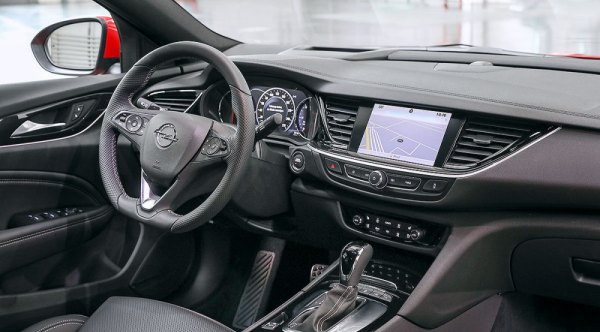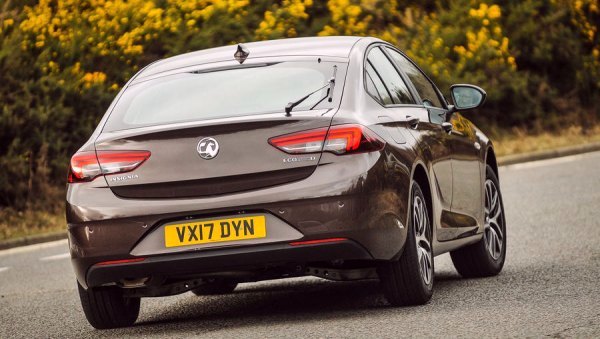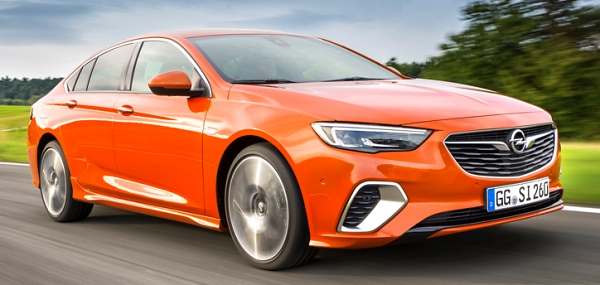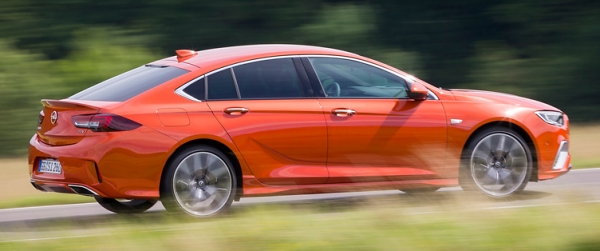Published
on 3
Apr 2017
|
All rights reserved.
|
|
|

|
|
Insignia
Grand Sport is the last Opel developed fully under the ownership of GM.
|
|
The launch of the second
generation Opel Insignia, or officially Insignia Grand Sport, could not
come at a worse timing. Just before it went on sale, parent company GM
announced the sale of its European operation to PSA group, ending an
ownership that dates back to 1929. In the past 5 years or so, Opel has
been working hard to turn around itself. It has renewed all its model
lines, added the niche Adam and is replacing its old-fashioned MPVs
with crossovers. It tried to build a green image by badge-engineering
Chevrolet Volt to Ampera. It supplied the old Insignia to Buick and is
offering the new car to replace Holden Commodore. In short, it tried
everything it can but, somehow, failed to turn black. In fact, it has
been losing money in each of the past 16 years. So frustrated that the
American opted to quit Europe altogether. Consequently, Insignia Grand
Sport becomes the last Opel developed fully under the ownership of GM.
Coincidence or not, the Insignia GS is also the most American-like big
car. For starter, it is a lot larger than the old car, being 4.9m long,
1.86m wide and runs a 2829mm wheelbase – the latter is 92mm up from the
last generation. Its sleek, handsome shape returns a Cd of only 0.26,
while the expressive design owes more to American than German school.
Rebadge it as a Buick and no one would feel strange. Its low roof line
– some 29mm lower than before – and steeply raked C-pillar may earn it
equal status to Audi A5 Sportback or Volkswagen Arteon (new CC), yet
the Opel is as affordable as ever. Like American saloons, it offers
more space and kits for the money.

|
|
Steeply
raked C-pillar may earn it equal status to Audi A5 Sportback, yet the
Opel is as affordable as ever.
|
|
Inside, it is remarkably close to Buick, too. The interior design is
quite stylish. Infotainment system is up to date, if not outstanding.
Materials are generally high quality, although the lower half of the
dashboard is made of hard plastics to save cost. Switchgears, fit and
finish are not quite premium grade, but it is probably higher than Ford
Mondeo/Fusion’s. The seats are supportive and comfortable. Driving
position is good and ergonomics is sounded. The cabin feels easily more
spacious than before. There is vast of rear legroom thanks to the
wheelbase extension. Predictably, rear headroom is not as good due to
the swoopy roofline, but by mounting the rear seat 30mm lower it is
still good enough to fit 6-footers, just. The only real drawback is the
boot, which shrinks by 40 liters to 490 liters, smaller than the class
norm.
The new large car is built on GM’s E2XX platform which also underpins
Chevrolet Malibu and Buick LaCrosse in the USA. Its chief progress is
weight reduction. The monocoque chassis is made 60 kg lighter, thanks
to using high-strength steel and aluminum bonnet. As before the
suspension is struts up front and multi-link at the rear (4WD models
have 5 links instead of 4 links). There won’t be torque-steer-reducing
HiPer strut anymore because Opel has dropped the poor selling OPC
version this time around. This means, the most powerful engine will be
the 260 hp 2.0 Turbo, which is coupled to the new Aisin 8-speed
automatic transmission and GKN Twinster 4WD system with torque
vectoring (like Ford Focus RS). Another new engine is the mass-selling
1.5-liter direct injection turbo with 165 hp. It can be equipped with
either 6-speed manual or 8-speed auto. If these are familiar, it is
because you have already seen them on Chevy Malibu. Exclusive to the
European car is diesel engines, of course. These include a 1.6-liter
with 110hp, 136hp or 160hp, or 2-liter with 180hp. At the lower end of
the range, the 1.5T petrol is available in 140hp tune.

|
|
The cabin feels
easily more spacious than before, thanks to the wheelbase boost.
|
|
On the road, the Insignia GS also goes quite like a Buick. It is
neither sporty nor fun to steer, but it is smooth and comfortable to
cruise along. With very long high gears, the 165hp 1.5T engine cruises
at motorway speed with only 2500 rpm on the rev counter, no wonder it
is remarkably hushed. When you want to overtake, engage the light
clutch and sweet gearbox, you will find the small turbocharged motor
offers plenty of useful torque, and then the car gathers speed
willingly, if never dramatically. In corners, the new car’s lighter
weight is evident, as it threads through corners willingly despite the
growth in dimensions. However, there is little feel from the electric
power steering. The chassis tuning is not as hardcore as Ford or Mazda
either, so it lacks the sharp turn-in or composed body control of its
rivals. On the flipside, the car cruises with superb ride comfort as
well as high-speed stability.
On the 2.0 Turbo 4x4 fitted with 18-inch wheels (instead of 17-inch of
lesser models), the ride comfort suffers some losses, especially on pot
holes or rough surfaces, while tire noise is more evident on cruising.
Opt for the largest 20-inch wheels and it becomes nearly unbearable, so
it is best to save money. This car has electronic adaptive dampers
fitted as standard, so you can alter the suspension stiffness between
Comfort and Sport mode. However, the former lacks body control to
inspire driving thrills, while the latter returns a ride too harsh to
be enjoyable on back roads. It proves that Opel has yet to master the
art of ride and handling like Ford, Mazda or even Volkswagen. In fact,
the 2.0 Turbo 4x4 may disappoint customers who expect a lot from its
name. It is simply not fast enough (0-60 mph takes just under 7
seconds). Its Aisin automatic has long gearing to promote fuel economy,
and it does not downshift quick enough when you call for action. The
result is a lukewarm performance. Even the Twinster 4WD here is not as
remarkable as on Ford Focus RS, because all it does is to maintain the
neutral handling without permitting the slightest drift on throttle.
The result is a secured driving manner like Audi’s Quattro.

|
|
The result is
less than the sum of its components...
|
|
Sadly, the last Opel developed under the GM umbrella fails to break
away from the usual mold of Opel. It has the necessary ingredients in
place, such as Twinster, adaptive dampers, multilink suspension, new
turbo motors and even a good look, but the result is less than the sum
of its components. Given more development time and budget and I think
it could have a good chance to succeed. Unfortunately, for a subsidiary
losing money in the last 16 years, GM ran out of patience.
|
Verdict:    |
Published
on 28
Feb 2018
|
All rights reserved.
|
|
Insignia GSi and Buick Regal GS
|
|

|
|
The
GSi has its flaws polished and transformed itself into a very handsome
machine...
|
|
Unlike
the last generation, the current Insignia is not going to have the OPC
high-performance model. It might sound strange, because its Twinster
4WD system should be able to take on more power than the existing
260-horsepower 2.0T engine can produce. Now we know why: if you are
planning to offload your loss-making subsidiary, you are unlikely to
invest further money and effort into its future. Without the money,
Opel has to settle on a lukewarm nameplate: GSi.
If you focus on power, the Insignia GSi will be disappointing, since it
keeps the 260hp 2.0T engine and Aisin 8-speed automatic transmission
intact. There’s not much problem with this powertrain combo, just don’t
assume it is a performance car. What Rüsselsheim did is enhancing
its looks and handling. The former is really cool, thanks to a cleaner
front bumper with two chromed intakes, side skirts, a rear spoiler and
a pair of chromed, rectangular exhaust that mirrors the front intakes.
Whereas the regular Insignia has a beautiful shape let down by the
details, the GSi has its flaws polished and transformed itself into a
very handsome machine.
To improve handling, the suspension of GSi is lowered by 10mm and its
springs stiffened by 40 percent. CDC adaptive dampers are fitted
standard, whose stiffness can be controlled across 4 modes. Ditto the
engine, transmission, steering and 4WD mapping. 235/35ZR20 Michelin
Pilot Sport 4S tires offer more grip, while braking performance is
enhanced by fitting 345mm front discs with Brembo 4-pot calipers, while
the rears are upgraded to 315mm ventilated discs.

|
|
There
is not much fun to have during the drive, but they are effective
high-speed cruisers...
|
|
Power-hungry American and Australian are slightly luckier, because
their versions of the car, i.e. Buick Regal GS (GS = Gran Sport) and
Holden Commodore VXR (not a real Commodore, of course), employ a V6
instead. However, don't be too excited. This is GM’s normally aspirated
3.6-liter V6 currently used on some Cadillacs (mounted longitudinally)
and Buick LaCrosse (transversely like Regal). While it is suitably
advanced, with direct injection, DVVT and cylinder deactivation
technology, its needs to rev to 6800 rpm to squeeze out the 310 peak
horsepower, or a rather high 5200 rpm to realize its 282 pound-foot of
peak torque. That’s no match for modern turbocharged motors or classic
Chevy V8. Therefore, at no time the cars feel as quick as, say, a BMW
340i, or to lesser extent the Ford Fusion V6 Sport. It is only in the
same ball park of fast Camry, Accord and Maxima. Note that the V6 comes
with a different transmission, i.e. a new 9-speed automatic developed
jointly by GM and Ford. It works nicely with the engine, delivering
smooth performance and less delay than the Aisin 8-speeder of Opel,
thanks to an excellent calibration. That said, the lack of shift
paddles is an unforgivable oversight for something with a hint of
performance.
Both the Opel and Buick have similar chassis behavior. Their steering
feels numb regardless of modes, which alter weight but not feel. It
also lacks the turn-in response and the kind of neutral handling
demanded by keen drivers. There is not much fun to have during the
drive, but they are effective high-speed cruisers, thanks to a smooth
ride in comfort mode, and the cabin is well insulated from noises.
Switch to sport mode and body roll is reduced, but the ride suffers
noticeably on rough surfaces. The GKN rear axle offers dependable
traction and grip, but unlike Ford Focus RS, you can hardly sense any
torque vectoring. This chassis is still default to understeer under
pressure.
Fortunately, you spend minimal extra on the minimal return. All these
cars are sold at a slight premium over their regular versions thus they
are good value. There are plenty of motorists love the looks of sporty
cars without wanting the price. Opel Insignia GSi and Buick Regal GS
might suit them.
|
Verdict:    |
|